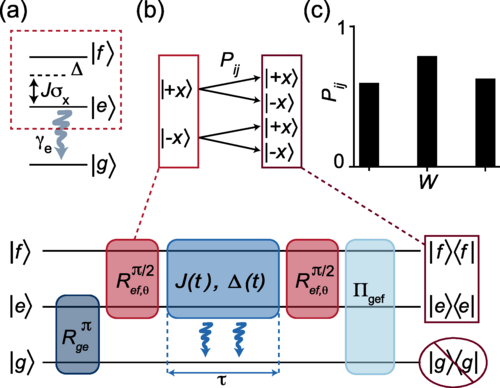Researchers from Washington University and Indiana University-Purdue University have studied the work fluctuations of non-hermitian dynamics in a superconducting qubit. The team demonstrated that these fluctuations obey the Jarzynski equality, even if the Hamiltonian has complex or purely imaginary eigenvalues. The study provides a new perspective on the work fluctuations in a non-hermitian qubit, which could have significant implications for the understanding and applying quantum systems, particularly in the context of superconducting qubits. The findings also contribute to the ongoing debate on the validity of fluctuation theorems in systems governed by a non-hermitian Hamiltonian.
What is the Impact of NonHermitian Dynamics on Work Fluctuations in a Superconducting Qubit?
A team of researchers from the Department of Electrical and Systems Engineering and the Department of Physics at Washington University, St Louis, Missouri, and the Department of Physics at Indiana University-Purdue University, Indianapolis, Indiana, have conducted a study on the work fluctuations of non-hermitian dynamics across the exceptional point of a superconducting qubit. The study was received in October 2023, revised in February 2024, accepted in March 2024, and published in April 2024.
The researchers explored the constraints of thermodynamics on the energy changes of a system, both deliberate and random, through its first and second laws. They focused on the system when it is not in equilibrium, where fluctuation theorems such as the Jarzynski equality further restrict the distributions of deliberate work done. These fluctuation theorems have been experimentally verified in small nonequilibrium quantum systems undergoing unitary or decohering dynamics. However, their validity in systems governed by a non-hermitian Hamiltonian has been contentious due to the false premise of the Hamiltonian’s dual and equivalent roles in dynamics and energetics.
The team demonstrated that work fluctuations in a non-hermitian qubit obey the Jarzynski equality, even if its Hamiltonian has complex or purely imaginary eigenvalues. They used postselection on a dissipative superconducting circuit undergoing a cyclic parameter sweep to quantify the work distribution using projective energy measurements experimentally. They showed that the fate of the Jarzynski equality is determined by the parity-time symmetry of and the energetics that result from the corresponding nonHermitian Floquet Hamiltonian.
How Does Thermodynamics Apply to Open Quantum Systems?
The concept of a small system coupled to a large reservoir is elemental to both thermodynamics and open quantum systems. In thermodynamics, a reservoir distinguishes between two types of energetics: heat (Q), the random energy transferred to the system from the reservoir, and work (W), deliberately imparted to the system. The energy (U) of the system is additively changed by the two, thereby encoding the first law of quantum thermodynamics.
Conversely, a closed quantum system is governed by a Hermitian Hamiltonian (Ht), undergoes unitary evolution with zero heat exchange, and its energy is equal to the expectation value of the generator of its dynamics (Ht). When coupled to a reservoir, one describes its evolution by averaging over possible consistent microstates of the reservoir. This averaging leads to engineered decoherence and dissipation, with the resulting dynamics described by a Lindblad equation.
What is the Jarzynski Equality, and How Does it Apply to Quantum Systems?
The work-energy theorem and work fluctuations of a non-equilibrium system with an internal energy operator (Ht) are further constrained by the Jarzynski equality. This equality supersedes the Jensen inequality that constrains the work done on a system and its free-energy change. In a quantum system with indefinite energy, a two-point-measurement (TPM) protocol quantifies changes in a system’s energy in terms of transition probabilities between energy eigenstates of the internal energy operator (Ht).
The transition probabilities differ for unitary and Lindblad evolution, yet the Jarzynski equality holds for unital quantum maps, as has been experimentally verified. The researchers showed that for cyclic parameter variations in Hefft, the average exponentiated work is unity when the corresponding Floquet Hamiltonian (HF) has a parity-time symmetry, and its Floquet energy operator matches the system’s initial energy operator.
What is the Role of NonHermitian Dynamics in Quantum Systems?
Recently, a third model of quantum dynamics has emerged, obtained by postselecting on quantum trajectories with no quantum jumps. With a non-hermitian generator (Hefft) and a nonlinear trace-preserving equation of motion, it maps pure states into pure states. Still, it changes the entropy of mixed states, thereby commingling salient features of unitary and Lindblad evolution.
These non-hermitian systems occur by considering a subspace of the larger dissipative system governed by Lindblad evolution. When the nonHermitian Heff has a real spectrum, its role in dynamics has been conflated with energetics, leading to predicted violations of the Jarzynski equality.
What are the Implications of the Study?
The study by the team of researchers provides a recipe for investigating the nonequilibrium quantum thermodynamics of open systems. By distinguishing the energetics from nonHermitian dynamics, the results offer a new perspective on the work fluctuations in a nonHermitian qubit. This could have significant implications for the understanding and application of quantum systems, particularly in the context of superconducting qubits. The findings also contribute to the ongoing discourse on the validity of fluctuation theorems in systems governed by a non-hermitian Hamiltonian.
Publication details: “Constraining work fluctuations of non-Hermitian dynamics across the exceptional point of a superconducting qubit”
Publication Date: 2024-04-16
Authors: Serra Erdamar, Maryam Abbasi, Byung Ha, Weijian Chen, et al.
Source: Physical review research
DOI: https://doi.org/10.1103/physrevresearch.6.l022013

